Donato de’ Bardi, the Presentation of Jesus at the Temple
The Presentation of Jesus at the Temple is the piece that made it possible to discover Donato de’ Bardi, thanks to Federico Zeri.
This Presentation of Jesus at the Temple is a pivotal work in Italian painting of the first half of the 15th century and forms the central element of Federico Zeri’s masterful reconstruction of Donato de’ Bardi’s artistic personality, carried out in 1973 and 1976. It was painted on a single wooden panel (possibly poplar), whose dimensions were slightly altered in modern times by the addition of a thin strip of wood along the lower edge and the grafting of a small cimasa at the center of the upper edge. Thus modified, and likely inserted into a frame of Renaissance style (this remains a hypothesis, as no evidence survives), the work would have appeared as a small, autonomous altarpiece, somewhat larger than average.
Considering the subject matter, however, Zeri noted that “it remains uncertain whether it was originally created as part of a gospel series, an altarpiece, or rather as a single and isolated element—a possibility that nonetheless leaves me very perplexed.”
No other panel considered complementary to this one is known today. This question might be resolved if it were possible to establish the work’s original location or provenance; however, current scholarship does not trace it further back than the 1960s–1970s, when it was held at the Galleria Lorenzelli in Bergamo—one of the most enterprising and lively “workshops” in the field of ancient painting in Italy.
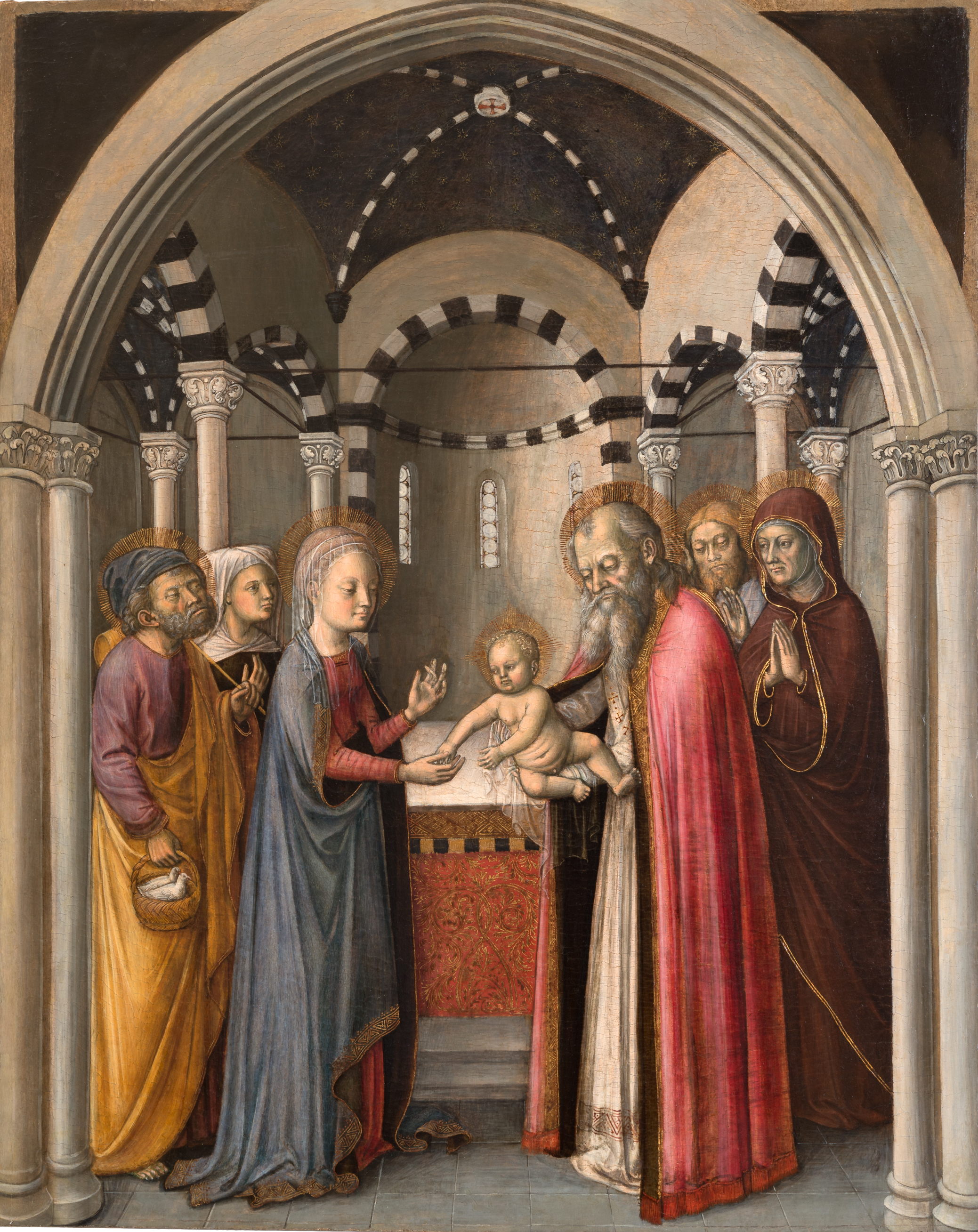
Barbara Ferriani’s delicate restoration work (2007) returned the painting to its original size and restored the luminous transparency that the old varnish had dulled on the pictorial surface. One can now fully appreciate the technical refinement of the execution: the exquisite fineness of the gold trim along the edges of the robes and halos, semi-transparent and radiant, and the minute detailing of the facial features and fabric folds. This level of detail may mislead those who only knew the painting from photographic reproductions, rather than seeing it in person, about its true dimensions.
Reflectography carried out during the restoration revealed the sharp and energetic outline of the underlying drawing, applied directly onto the chalky ground without major pentimenti. The drawing is especially precise in defining the most expressive features—such as St. Joseph behind the Virgin, and Simeon and the prophetess Anna behind him—demonstrating how, “in Donato, at this stage of his development, the light source, although carefully identified and subtly distributed in its reflections, remains accessory to the drawing, which is predominant and essential in defining the image.”
With the exception of the converging lines of the stone slab floor, whose ruler-like layout can be perceived, the reflectographic image does not reveal a rigorously constructed perspective. Despite the architectural elements converging toward a single focal point—the capitals, the iron bars linking the arches, and the progressive descent of the arches toward the apsidal space—the painting is based on an empirical conception of perspective, compensated by the varying intensity of light. This use of light allows us to perceive “the respective distances between figure and figure, between people and environment.”
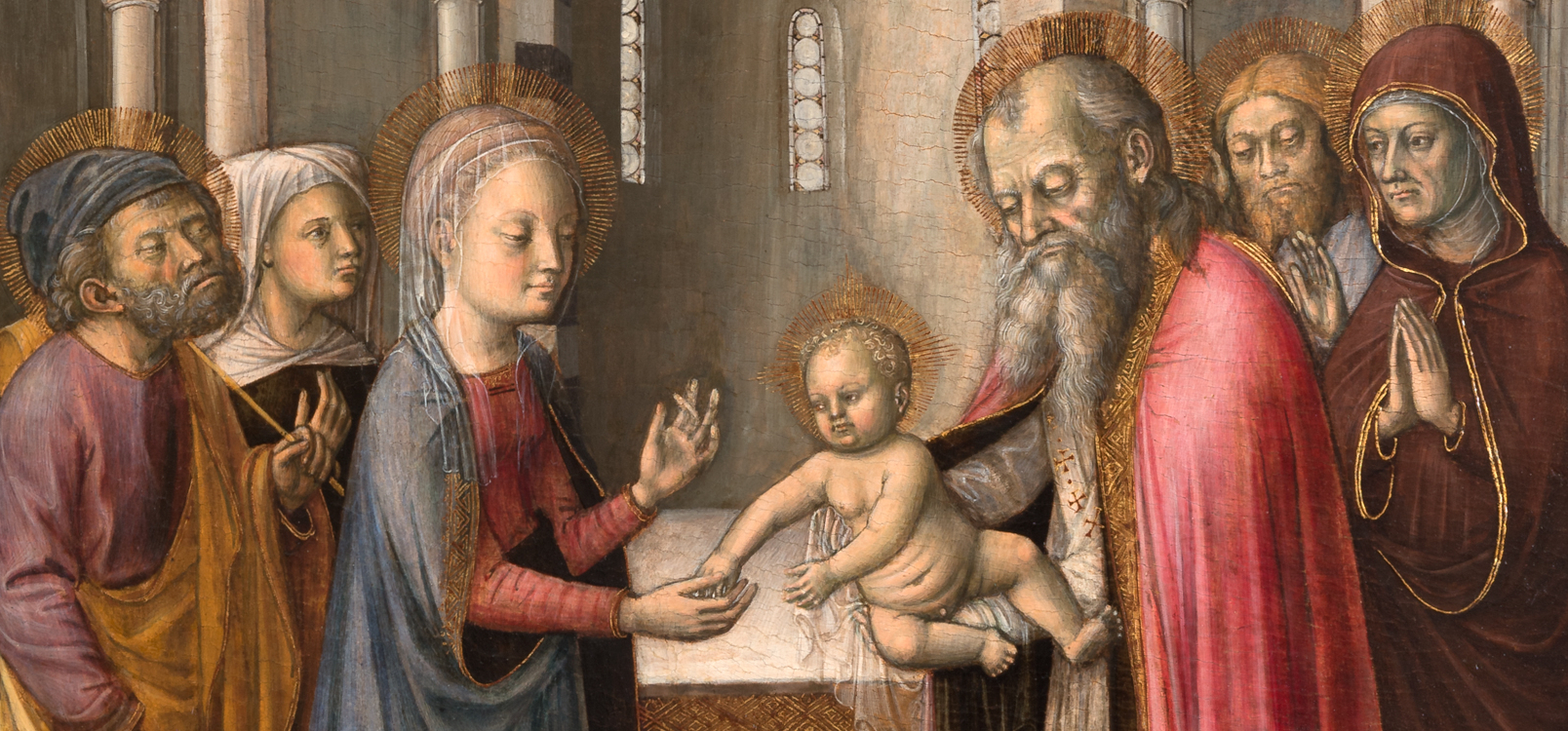
Prior to the publication of Federico Zeri’s study in 1973, knowledge of Donato de’ Bardi was limited to a monumental canvas (238 x 165 cm) depicting the Crucifixion, housed in the Pinacoteca Civica in Savona. This painting bears the signature on a card with crumpled edges: “Donatus comes bardus pa / pie[n]sis pinxit hoc opus”. Additionally, information came from documents rediscovered by Federico Alizeri in the Genoese archives.
Donato first appears in Genoese records in 1426 and again in 1433, when on March 20th he undertook a commission from Oderigo da Cremona, canon of Genoa Cathedral. This commission was for an altarpiece featuring Saint Mary Magdalene at the center, flanked by saints and crowned by the Crucifixion and other sacred figures—likely intended for one of the cathedral’s altars. No trace of this work remains, but the considerable fee (eighty lire of Genoa) and the prestigious destination testify to the eminent position Donato, originally from Pavia, had achieved in the city.
Despite his professional success, Donato and his younger brother Boniforte—also a painter, known from documents dated 1434 to 1453—seem to have faced serious financial difficulties. Alizeri’s recovered papers include a series of petitions addressed to the Anziani and the Doge, requesting tax exemptions and concessions. The earliest, from 1434, coincides with a balance due for a lost decoration at Palazzo San Giorgio in Genoa. Another, from 1448, reveals Genoese goldsmiths advocating on Donato’s behalf, praising his art and acknowledging the benefits they derived from it (“quod sit utilis ministerio aurificum”). Finally, in 1450, Boniforte poignantly described his plight: “born a Lombard nobleman and lord of lands, his possessions were sacked by soldiers, forcing him to relocate to Genoa. There, he practiced painting for a living—an art he once pursued only for pleasure—but he was persecuted by tax authorities, who even confiscated his household utensils”.
Although this account may be colored by pietistic rhetoric, it casts a grim light on working conditions in Genoa during the early 15th century—particularly striking given the city’s vibrant artistic market and production during this period. Donato himself is not mentioned in this document; the last known reference to him dates to June 30, 1451, when another Pavia painter, Giovanni Giorgio, promised Giacomo Pelizzari of Pontremoli to complete a majesty with saints left unfinished by the late de’ Bardi.
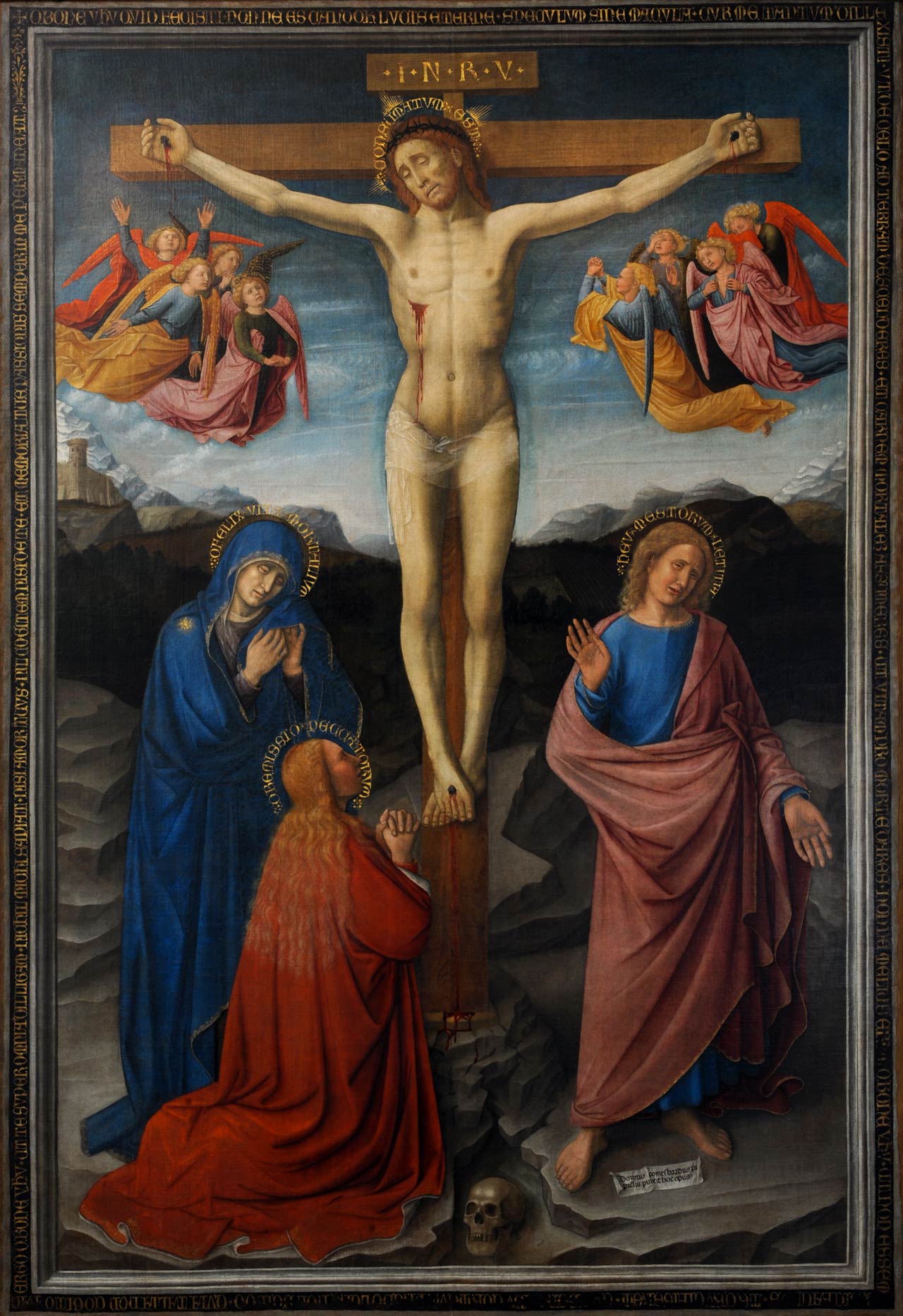
Early appreciators of Donato de’ Bardi’s work had only one painting and scant documentation at their disposal. Alizeri, who linked the signed painting to archival evidence, openly admired the Savona canvas, recognizing its “style closer to the modern than the age would suggest.” His appreciation went largely unnoticed for nearly forty years, until Wilhelm Suida, in a pioneering investigation of 15th-century Lombard painting, highlighted the uncommon qualities of the Crucifixion and emphasized its impact on Vincenzo Foppa’s artistic formation.
Building on Suida’s “rediscovery”, Pietro Toesca devoted the final pages of his monumental volume on Lombard painting and illuminated manuscripts to the “great novelty of Donato de’ Bardi.” Toesca questioned the origin of these “new forms” and identified “in the folding of fabrics […] some influence from beyond the Alps.” Probably inspired by the studies of Suida and Toesca, Bernard Berenson visited Savona in 1912, noting in his copy of the Municipal Art Gallery catalogue: “Extremely important transitional master […] certainly influenced by Fra’ Angelico.”
It was, however, Roberto Longhi—writing in a brogliaccio dedicated to his Maestro Raro, which we know thanks to the fine edition edited by Simone Facchinetti of his essay on Carlo Braccesco—who first clearly recognized the transalpine influence in the Crucifixion. Longhi remarked: “It is worth remembering that Italy had its Fouquet most likely in Liguria, in the Pavia-born Donato de’ Bardi […]. Something that is not Italian is in the body of Christ.” He later emphasized the Nordic elements of this singular and unique painting by the “mysterious ‘Comes Papiensis’,” stating that “the work is more a friend of Van Eyck and Petrus Christus than of Masaccio.”
This judgment was confirmed in notes Longhi wrote while visiting the 1946 restoration exhibition in Genoa, where Antonio Morassi had assembled some eighty old paintings, removed from their original locations to protect them from war damage. Longhi observed: “In the 15th century, local culture declines. Flanders, Lombardy, and Piedmont dominate. Often, poor painters were sent there; but great men worked in Savona and Genoa—before 1450, Donato de’ Bardi; and in the last twenty years of the century, the Milanese Braccesco […] and Vincenzo Foppa.”
In a more informal tone, Longhi reiterated this assessment in a letter to the young Federico Zeri (shortly before August 4, 1946), after visiting the Genoese exhibition: “Among the 15th-century painters […] there is only one work that belongs to the highest sphere: it is Donato de’ Bardi of Savona—one of the greatest of the first half of the century.”
The Savona masterpiece remained an isolated presence in the major 1958 exhibition Arte lombarda dai Visconti agli Sforza (Lombard Art from the Visconti to the Sforza dynasty), where the close link between the Pavia-born painter and Foppa was already emphasized: “By 1462 […] Foppa was already making his first excursions to Liguria, a land of conquest for the Lombards, since a mysterious painter, Count Donato de’ Bardi from Pavia, had settled there in 1426. His admirable Savona Crucifixion is present here, which, before 1451 (the year of the artist’s death), marks the highest conjunction between Po Valley Italy and the Burgundian and Flemish civilization of Sluter, Limburg, and Van Eyck.”
This concise and somewhat enigmatic statement seemed to herald an imminent discovery. In fact, Longhi himself had touched upon it earlier when he attributed to Donato Bragadin—the name to which the work was commonly referred—the triptych with the Madonna of Humility, the Child and Saints Philip and Agnes at the Metropolitan Museum of Art in New York, displayed alongside the “beautiful panel” of the Presentation of Jesus at the Temple, “of a later moment,” recognizing in both the hand of a great painter.
The great exhibition at Palazzo Reale also allowed for illuminating comparisons and analyses. Wilhelm Suida, in a thoughtful commentary, identified Donato de’ Bardi of the Savona Crucifixion as Foppa’s great precursor, placing him alongside the author of two panels with St. Stephen and St. Ambrose in the Cicogna Mozzoni collection, both stylistically and chronologically (around 1450). Zeri, following a suggestion by Giovanni Romano, would later assign these works to the last phase of the Pavia master’s career.
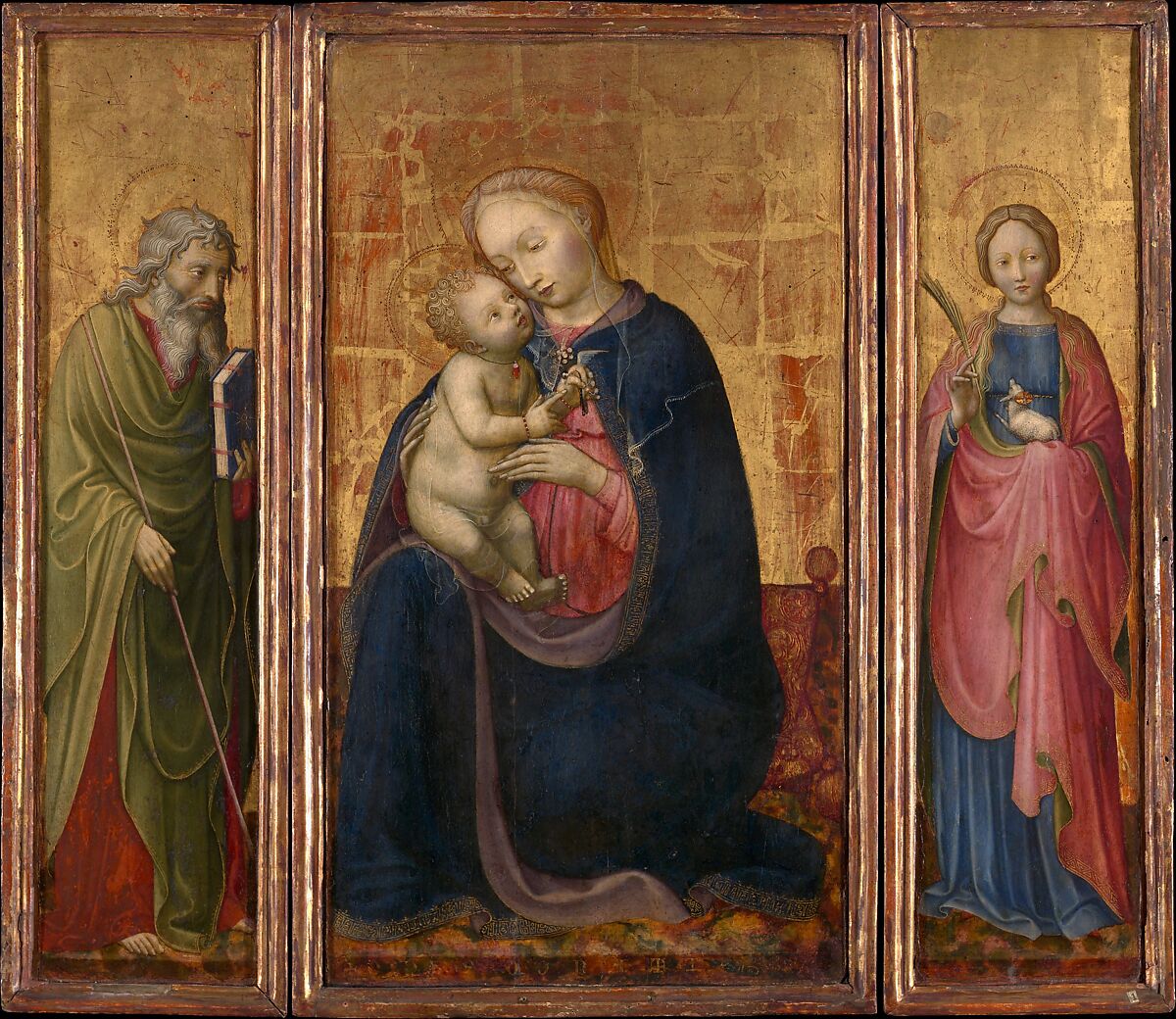
Federico Zeri’s recovery of Donato de’ Bardi’s artistic personality emerged from this context and is closely linked to his research on Italian paintings at the Metropolitan Museum in New York. Thanks to studies by Andrea Bacchi and Luca Mattedi, we can now trace the extensive correspondence between Zeri and the museum from 1948 to 1988. Zeri signed the contract to draft the American catalogue in 1961, but the volume—including the entry on the small triptych Madonna of Humility with Child and Saints Philip and Agnes, signed “opus donati” (inv. 37.163.1-3)—was only published in 1986.
Research into the triptych’s cultural identity began in the 1970s. According to Miklos Boskovits, who visited Mentana’s studio during those years, Zeri worked with intense focus on the elements that would become central to his seminal essay on de’ Bardi. Zeri’s analysis identified structural features (the triptych’s rectangular, ornament-free profile) and formal qualities that were alien to Venetian culture and the modest, late Donato Bragadin to whom the work had traditionally been attributed. This allowed him to detach the masterpiece from traditional attributions and reveal in it not only extraordinary technical quality but also the influence of a highly refined culture beyond the Alps.
Beyond a Lombard undertone reminiscent of Michelino da Besozzo’s expressive naturalism, the painting shows a strong attraction to Franco-Flemish culture—not only in manuscript illumination (Zeri noted the two large sheets with Jean de Berry presenting Saints Andrew and John the Baptist, and the Madonna Enthroned with Child in the Royal Library of Brussels, ms. 11060-61, taken from the Très Belles Heures de Jean de Berry, painted before 1402) but also in sculpture, which offers striking comparisons.
For example, the elegant figure of Saint Agnes closely resembles the alabaster Saint Catherine attributed to André Beauneveu in the Church of Notre-Dame in Courtrai, once part of Count Louis de Mâle’s funeral monument (1374–1384). Similarly, the Candoglia marble statue of Saint Peter in the Milan Cathedral Museum (inv. ST 104), from pier 83 of the cathedral’s rear choir and attributed to Beauneveu’s circle, shares singular similarities in drapery with Saint Philip in the triptych. Both saints and the sculpture feature a calm, naturalistic treatment of the faces paired with elegant, elaborate folds in their clothing.
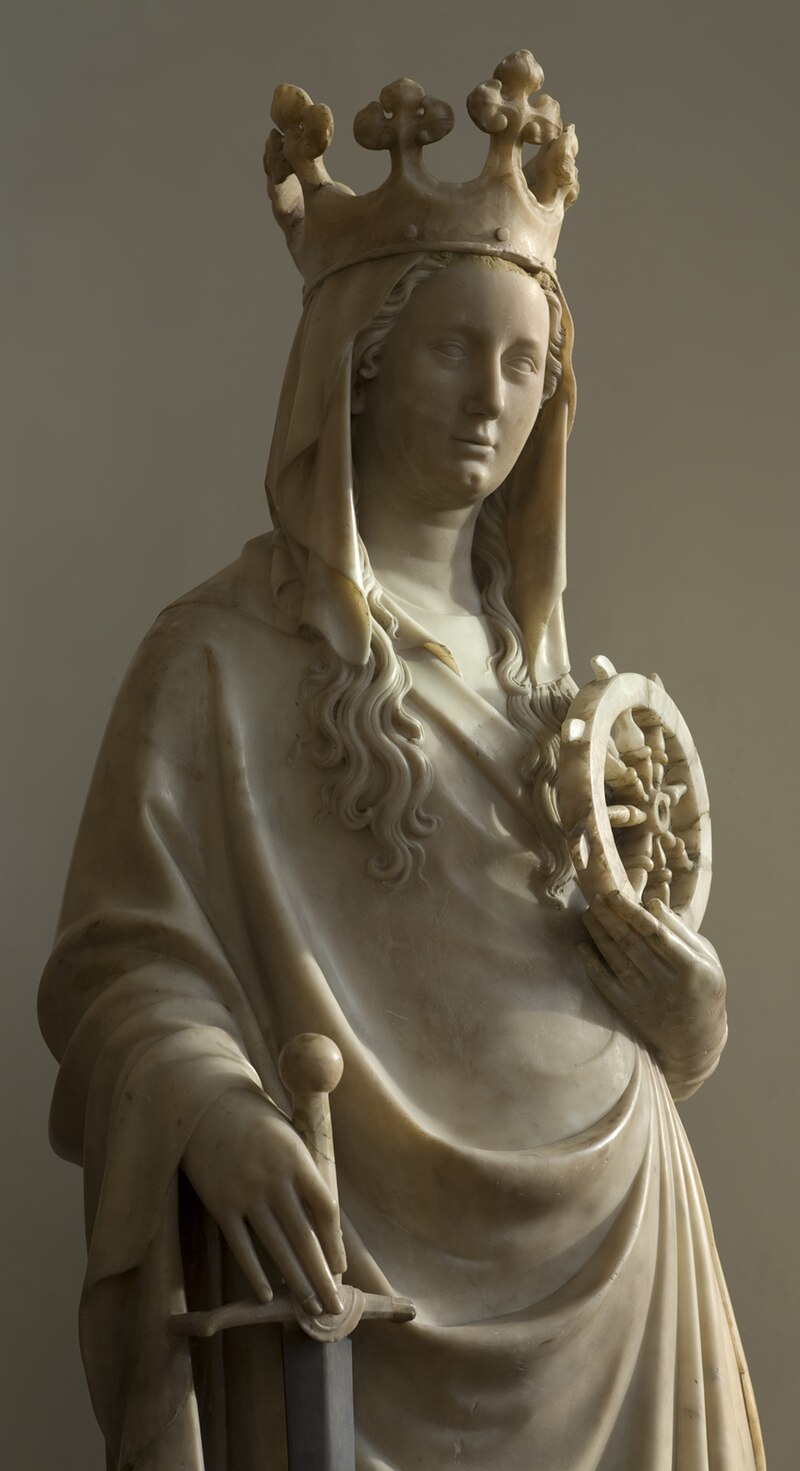
This Franco-Burgundian cultural influence in the Metropolitan triptych likely corresponds to a phase difficult to date precisely. It may have filtered into Lombardy and Genoa during the period when the Republic sought protection from the King of France (1396), especially under the governorship of Jean le Meingre, Marshal of Boucicaut (1401–1409), around whom a small court and connections with Valois France—including Dijon, Bourges, Paris, and Bruges—developed. Some scholars have also suggested the influence of Avignonese culture at this time, represented by the Master of Thouzon and Jacques Yverni, who around 1420–1425 painted the triptych now in the Galleria Sabauda in Turin for the marquises of Ceva.
The triptych’s original destination remains unknown. Carl B. Strehlke proposed it may relate to the cosmopolitan climate of the Visconti court in Pavia, suggesting the side panels’ saints might allude to Filippo Maria Visconti and his favored Agnese del Maino. Though the lack of heraldic evidence makes this hypothesis impossible to prove, it is an intriguing idea that would situate the commission in Lombardy.
Finally, an iconographic detail—the Franciscan belt under the Virgin’s cloak, noted by Zeri but later dismissed by him and overlooked by subsequent analysts—adds another layer of complexity to the painting’s interpretation.
The starting point for reconstructing the painter’s personality is thus a work that remains somewhat decontextualized. In the next phase, to which the Presentation of Jesus at the Temple belongs, the painter reveals an undeniable territorial connection: “by defining the architecture of the Temple, he wanted to give it an unmistakably Ligurian flavour: with small arches featuring alternating white and black ashlars, with the apse bare except for the three narrow windows, and with sails in dark blue interrupted by a star motif. The regional allusion is neither vague nor generic. Almost as if to seal the Ligurian nature of the panel, thwarting any possible doubts, the keystone at the top of the composition—hooking the four main sails—bears within its circle an inscribed red cross, the coat of arms of the city of Genoa.”
Here too, Lombard references persist. “And yet, the final flavour of this panel has something Nordic, something Flemish; a flavour that, in the interior scene, the light pervading the environment, and the tone of happy, lively human dignity sustaining the characters, recalls the world of Jan van Eyck and Petrus Christus.” Compared to the triptych signed by Donato, the cultural climate has changed considerably, and Flemish painting references begin to prevail. These are recognisable in specific motifs: the turban-shaped headdress worn by Joseph, similar to that depicted by Jacques Daret in the Adoration of the Magi (Gemäldegalerie, Berlin); the white wimple encircling the female figure’s head in the background, between Mary and Joseph, in a style akin to those in female portraits by Robert Campin and Rogier van der Weyden; and, perhaps more than coincidentally, the dynamic and unusual pose of the Child, stretched out towards his mother, echoes that in the Madonna and Child (Madonna Durán) attributed to van der Weyden (Madrid, Museo del Prado), widely disseminated through engravings and drawings.
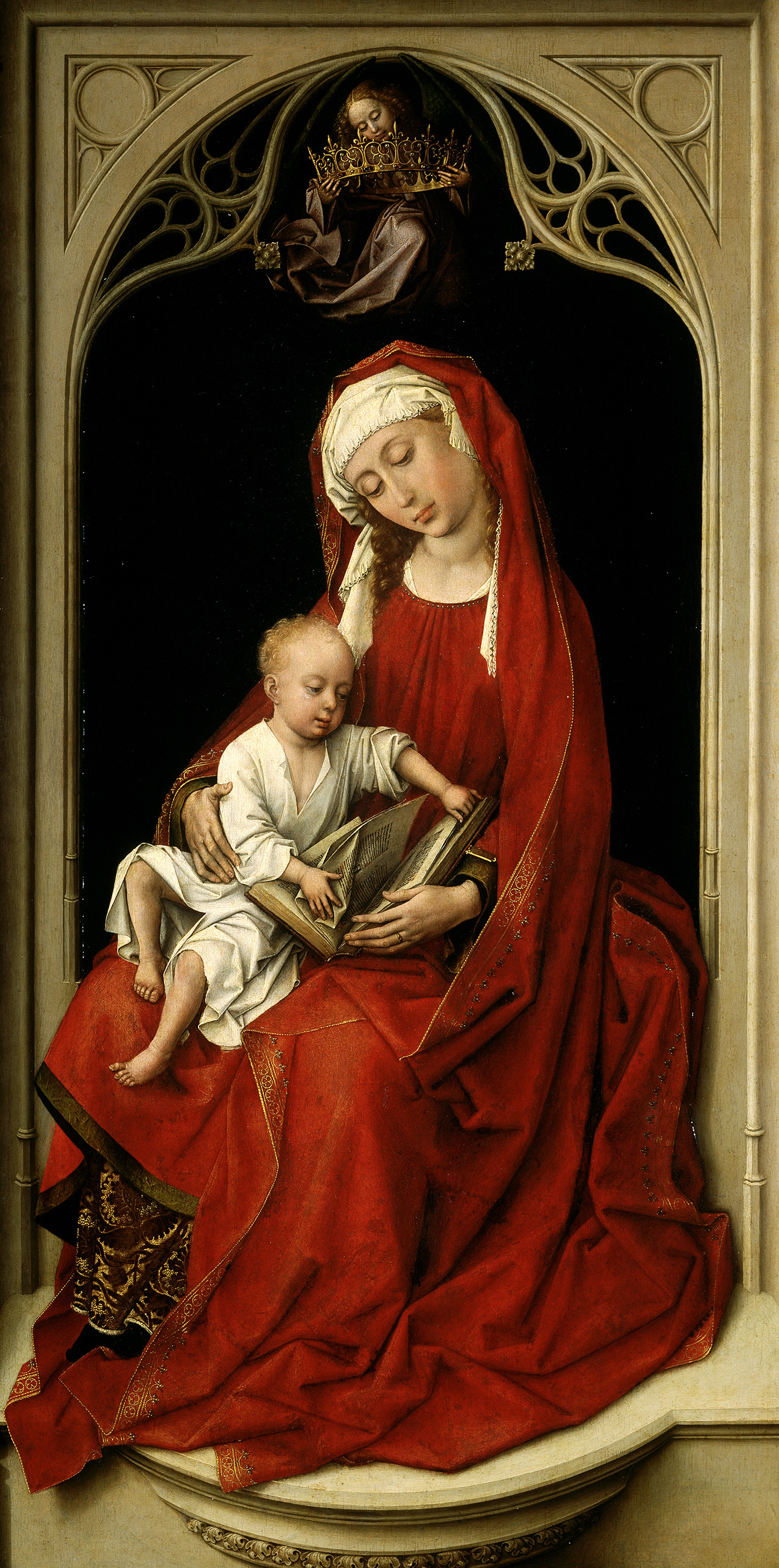
The figurative cosmopolitanism of Genoa in the first half of the century has been the subject of recent studies, and it is not the place here to recall the many works and artists who, alongside the persistent presence of late Gothic painting from Siena and Pisa, contributed to raising the figurative temperature of the region. In the years leading up to mid-century, the influence of Jan van Eyck—who never set foot on Ligurian soil—and the purist language of Petrus Christus became prevalent in a remarkably short span.
This new taste orientation is fully expressed in the great canvas masterpiece of the Savona Crucifixion, where Flemish sensibility coexists poetically with Fra Angelico’s abstract stones. It is also evident in the four saints Federico Zeri added to Donato’s catalogue in the latter half of the century: St Jerome, formerly at the Brooklyn Museum in New York and now in a private Italian collection; St John the Baptist, formerly at the Helikon Gallery in London and now in the Pinacoteca di Brera; and St Ambrose and St Stephen in private collections, which likely preceded the execution of the Savona canvas by a short time.

“As far as the formula of culture is concerned, the most valid datum remains the Lombard-Flemish agreement, conducted in ways that perhaps make it possible to identify the precise point of connection between Donato and Flanders.” The visual comparison between the bust of St Stephen and the bust of St John the Evangelist, painted in grisaille on the outside of the Polyptych of the Mystic Lamb by Hubert and Jan van Eyck (Ghent, St. Bavon Cathedral)—reproduced among the essay’s plates—convincingly clarifies the cultural attraction to which Zeri alluded.
Later, the art historian proposed extending Donato’s catalogue to include the Suckling Madonna in Milan’s Poldi Pezzoli Museum, an attribution I myself had suggested following discussions with the illustrious master. However, Giovanni Romano’s objections identified the painting as an early work by Bergognone, “datant peut-être déjà des années 1470.” Since then, the painting has remained suspended in this plausible but unproven attribution—an almost inextricable question of figurative philology that even the identification of the tiny cymatium originally completing the panel has not definitively clarified.
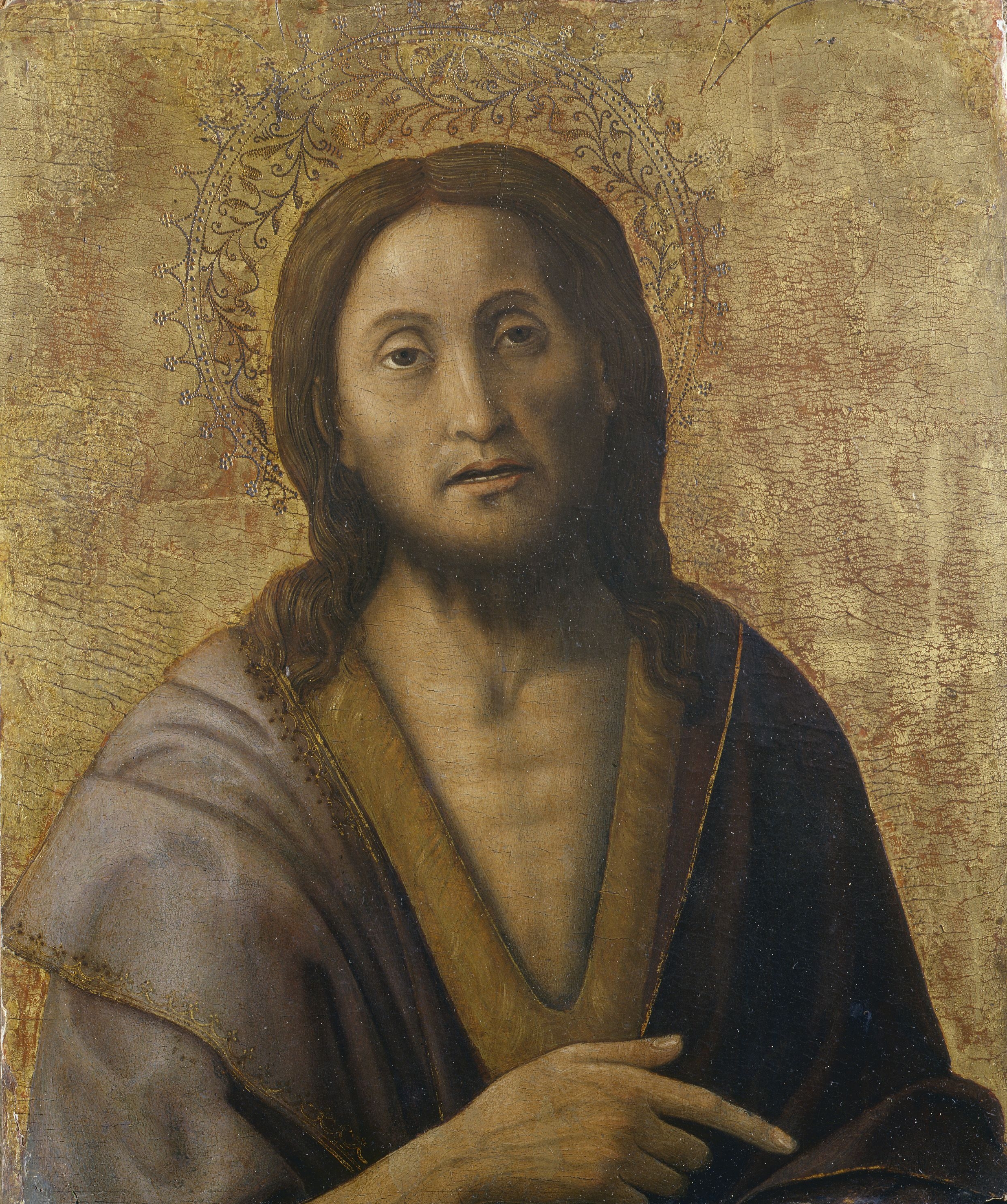
The painter’s Genoese beginnings were recognised by Zeri in the four saints of the Accademia Ligustica in Genoa: Catherine, John the Evangelist, John the Baptist, and Benedict. These are arbitrarily assembled and heavily damaged elements (the whole measures 113 x 115.5 cm; each panel is 33 cm wide) of a polyptych whose original location is unknown, and which probably included the Virgin and Child at its center. The art historian’s observations regarding the close analogies linking the physiognomic types of these four figures to the New York triptych remain entirely convincing and substantially hold up today, despite some scholars seeing this work as an epigonic product—“too solidly linked to local events of the late 14th century (between Taddeo di Bartolo and Nicolò da Voltri) for a painter of Lombard birth and training.”
Zeri pointed out the presence of the same splendid halos, executed with “the same irons, the same care in the execution and drafting of brushstrokes, resulting in a clear, precise, almost miniature-like lucidity.” The sweet, melancholic face of Saint Catherine, her locks spread on both sides of her head, and the anatomical rendering of the hand delicately holding the palm of martyrdom are motifs common to the Metropolitan painting and make the relationship between the two works evident.
Compared to the seductive elegance of the Oriental princess, the male saints accompanying her—though painted with similar technical excellence—reveal a more archaic approach. For the figure of St. John the Baptist, the reference models are the inventions of Taddeo di Bartolo, who was active in Liguria on at least two occasions (1390–1394 and 1397, including the Baptism of Christ in Santa Maria Assunta, Triora). It is likely that in Liguria, Donato de’ Bardi, confronted with the enduring success of the great altar works of Taddeo di Bartolo, the Pisan painters, and their Tyrrhenian followers, integrated some local formulas.
Reflectographic investigations conducted on the Accademia Ligustica panels revealed a common technique: “The marked strokes defining the faces of the male saints were obtained by superimposing darker tones over the light preparation and linear drawing.” It cannot be ruled out that this more expressive manner, which reappears with other human intensity in passages of the Presentation of Jesus in the Temple, indicates the presence of a collaborator—perhaps, as Clario Di Fabio suggests, Boniforte de’ Bardi, Donato’s brother.
The question of the authorship of the recomposed reredos in Genoa is closely linked to that of the documented Ligurian presence of the Pavia painter. Two recent, significant discoveries have made it possible to anticipate the dating earlier than previously indicated by Alizeri. Donato’s name (“nato Iohano li de Bardi, scolari papiensi”) appears in Pavia’s records among students authorized to receive clerical tonsure and minor orders. Although it is surprising that he began an ecclesiastical career, likely later abandoned, there is no reason to doubt the identity of this individual.
Equally plausible is the identification of the “magistro Donato de Papia,” who maintained a workshop in Genoa’s rione dei Banchi and is mentioned in a Savona document from 1405, as the very painter who signed the New York triptych and proudly inscribed his name on the Savona Crucifixion around 1450 or shortly before.
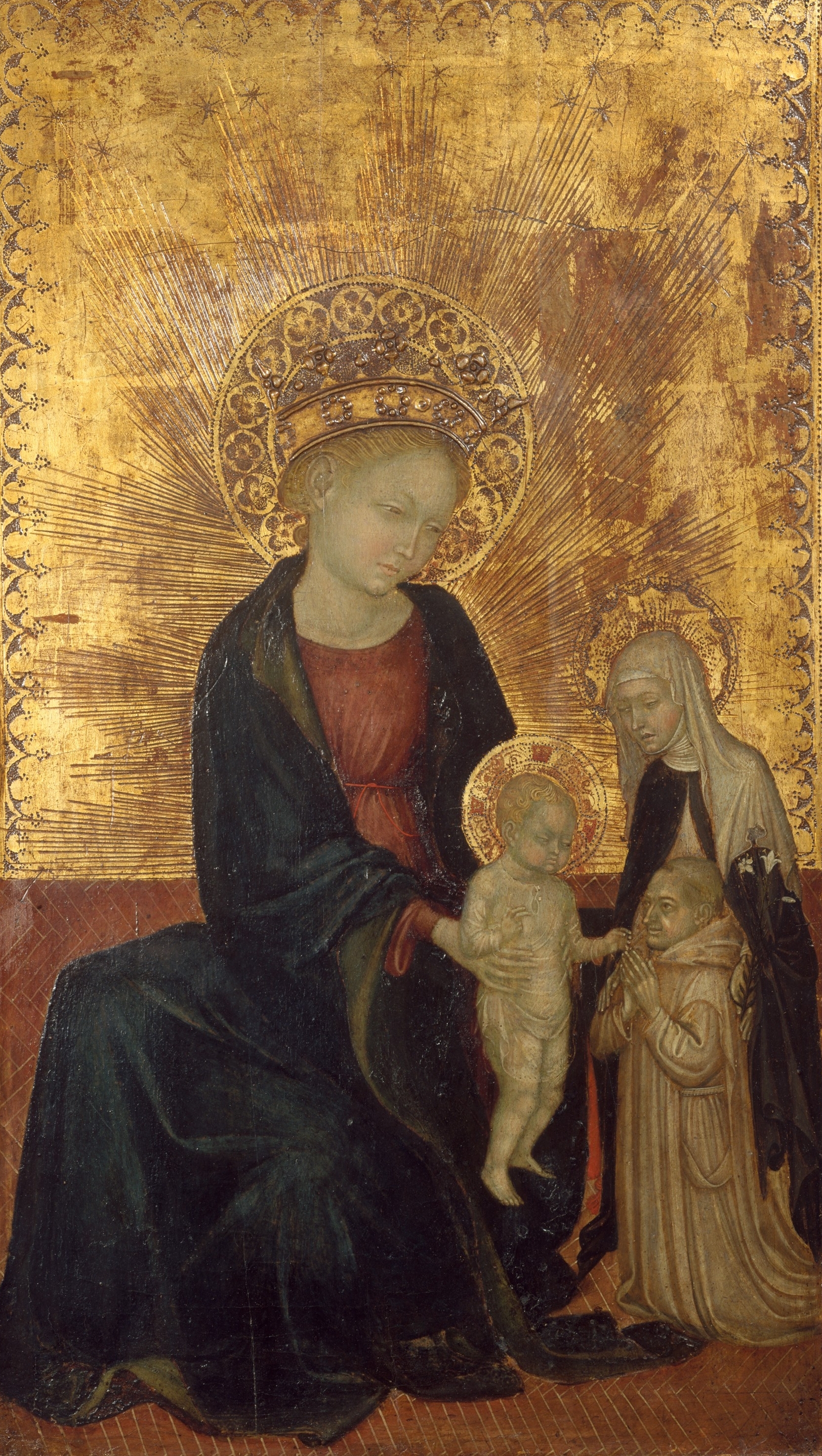
In light of these new documentary findings, it is tempting to recognize the beginnings—or at least the early premises—of the painter’s activity in the precious Madonna and Child, Saint Catherine of Siena, and a devout Carthusian monk from the Lehman collection at the Metropolitan Museum of Art in New York. This work, previously attributed to Cristoforo Moretti, has been progressively reassigned to Donato de’ Bardi in recent scholarship.
The monk whom the Sienese saint wraps in her mantle has been identified as Bartolomeo Serafini of Ravenna, prior of the Certosa of Pavia from 1397 to 1409. According to tradition, the Sienese mystic donated her mantle to him, and it was bequeathed to the Certosa upon his death in 1413.
As Stefania Buganza acknowledges, the attribution of this precious painting to Donato de’ Bardi—which she supports—is “not immediately obvious, [but] can help fill the gap leading from the Lehman Madonna to the sophisticated New York triptych, and the Madonna and Child in the Archbishop’s Palace in Genoa.” The latter is rightly attributed by Filippo Todini to the painter from Pavia and, despite its severely compromised condition, retains a poignant expressive force.
Whether this sequence truly reflects the beginnings of Donato de’ Bardi’s career or whether further attribution adjustments are needed, these new acquisitions imply a slight chronological shift in the earliest portion of his catalogue. Shortly after the Metropolitan Museum triptych, which probably dates to the 1420s (Zeri placed it “in the decade between 1430 and 1440, or perhaps even a little earlier”), should come the Madonna and Child of the Archbishopric and the Four Saints of the Accademia Ligustica.
The fundamental refinement deriving from comparison with Northern European painting—known through select examples present in Genoa during the first half of the century—likely belongs to the 1430s.
The Presentation of Jesus in the Temple represents a pivotal moment in this cultured transformation, which, in my view, does not require positing an apprenticeship trip to Provence or the Burgundian territories to explain. In the works completed in the last decade of his life—Saints Ambrose, John the Baptist, Jerome, Stephen, and the Savona Crucifixion—Donato de’ Bardi approached the great Northern models, from Jan van Eyck to Petrus Christus, with increasing engagement. It was probably then, before 1447, that the painter may have traveled abroad—to Lombardy or to territories with commercial, political, and cultural ties to the Visconti and, later, the Sforza.
However, these remain speculative hypotheses—like other still mysterious aspects of this magnificent painter’s life—that it is prudent to set aside until new, decisive evidence emerges.
Note: This essay is taken from the catalogue Solo una questione di Luce. L’Italia e il fascino delle Fiandre tra Quattro e Cinquecento (Just a Matter of Light: Italy and the Charm of Flanders between the 15th and 16th Centuries), edited by Mauro Natale and published by Galleria Carlo Orsi on the occasion of the exhibition of the same title, open to the public from 27 November 2024 to 31 January 2025.
September 3, 2025
